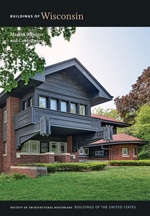
At least since the late nineteenth century, designers of public buildings have favored classical architecture for its close association with republican values. But their interpretations of classicism have changed over the years. In the 1930s architects stripped away such rich decoration as festoons and elaborate sculpture leaving only formal symmetry and massing. Ornamentation consisted of grooved or smooth pilasters, geometric chevrons and zigzags, and low-relief carving. This austere form of classicism persisted for a time after World War II, as evident in this courthouse designed by a Green Bay firm. Along much of the length of the two-story limestone building, smooth piers divide vertical bands of windows, which are separated into two levels by spandrels carved with shells in low relief. In the entrance bays on the building’s ends, bas-relief spandrels depict Native Americans and their first encounters with French Canadian voyageurs.

